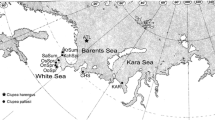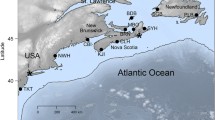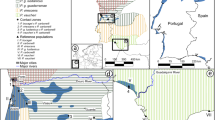Abstract
The process of hybridization between closely related species plays an important role in defining the genetic integrity and overall genetic diversity of species. The distribution range of Magellanic (Spheniscus magellanicus) and Humboldt (Spheniscus humboldti) penguins is predominantly allopatric; however, the species share a region of sympatry where they may hybridize. We analyzed four types of genetic markers (including nuclear and mitochondrial markers) to assess their utility in detecting hybridization events between Magellanic and Humboldt penguins. Genetic assessment of non-introgressed reference samples allowed us to identify three types of informative markers (microsatellites, major histocompatibility complex, and mitochondrial DNA) and detect positive evidence of introgressive hybridization in the wild. Four out of six putative hybrids showed positive evidence of hybridization, revealed by the detection of Humboldt mitochondrial DNA and Magellanic species-specific alleles from nuclear markers. Bayesian Structure analysis, including samples from the sympatric region of the species in the southern Pacific Ocean, confirmed the use of nuclear markers for detecting hybridization and genetic admixture of putative hybrids, but revealed relatively low levels of genetic introgression at the population level. These findings provide insights into the role of hybridization in regions of species sympatry and its potential consequences on the levels of genetic introgression, genetic diversity, and conservation of these penguin species.


Similar content being viewed by others
References
Akst EP, Boersma PD, Fleischer RC (2002) A comparison of genetic diversity between the Galápagos Penguin and the Magellanic Penguin. Conserv Genet 3:375–383
Aliabadian M, Nijman V (2007) Avian hybrids: incidence and geographic distribution of hybridisation in birds. Contrib Zool 76:59–61
Anderson E (1949) Introgressive hybridization. John Wiley and Sons, New York
Arauco-Shapiro G, Schumacher KI, Boersma D, Bouzat JL (2020) The role of demographic history and selection in shaping genetic diversity of the Galápagos penguin (Spheniscus mendiculus). PLoS One 15(1):e0226439
Arnold ML (1992) Natural hybridization as an evolutionary process. Annu Rev Ecol Syst 23:237–261
Arnold ML (1997) Natural hybridization and evolution. Oxford University Press, Oxford
Arnold ML, Buckner CM, Robinson JJ (1991) Pollen-mediated introgression and hybrid speciation in Louisiana irises. Proc Natl Acad Sci USA 88:1398–1402
Baker AJ, Pereira SL, Haddrath OP, Edge KA (2006) Multiple gene evidence for expansion of extant penguins out of Antarctica due to global cooling. Proc R Soc B 273:11–17
Barton NH (2008) The effect of a barrier to gene flow on patterns of geographic variation. Genet Res (Camb) 90:139–149
Barton NH, Hewitt GM (1985) Analysis of hybrid zones. Annu Rev Ecol Syst 16:113–148
Bertelli S, Giannini NP (2005) A phylogeny of extant penguins (Aves: Sphenisciformes) combining morphology and mitochondrial sequences. Cladistics 21:209–239
BirdLife International (2018a) Spheniscus magellanicus. The IUCN Red List of Threatened Species 2018: e.T22697822A132605485. https://doi.org/10.2305/IUCN.UK.2018-2.RLTS.T22697822A132605485.en
BirdLife International (2018b) Spheniscus humboldti. The IUCN Red List of Threatened Species 2018: e.T22697817A132605004. https://doi.org/10.2305/IUCN.UK.2018-2.RLTS.T22697817A132605004.en
Boersma PD, Frere E, Kane O, Pozzi LM, Putz K, Rey AR, Rebstock GA, Simeone A, Smith J, Van Buren A, Yorio P, García Borboroglu P (2013) Magellanic penguin. In: García Borboroglu P, Boersma PD (eds) Penguins: natural history and conservation. University of Washington Press, Seattle, pp 233–263
Bouzat JL, Walker BG, Boersma PD (2009) Regional genetic structure in the Magellanic penguin (Spheniscus magellanicus) suggests metapopulation dynamics. Auk 126:326–334
Bouzat JL, Lyons, AC, Knafler GJ, Boersma PD (2013) Environmental determinants of genetic structure in Magellanic Penguin breeding colonies of the Atlantic and Pacific Oceans. VIII International Penguin Conference. September 2–6, 2013. Bristol, United Kingdom
Bullini L (1994) Origin and evolution of animal hybrid species. Trends Ecol Evol 9:422–426
Cole TL, Ksepka DT, Mitchell KJ, Tennyson AJD, Thomas DB, Pan H, Zhang G, Rawlence NJ, Wood JR, Bover P, Bouzat JL, Cooper A, Fiddaman SR, Hart T, Miller G, Ryan PG, Shepherd LD, Wilmshurst JM, Waters JM (2019) Mitogenomes uncover extinct penguin taxa and reveal island formation as a key driver of speciation. Mol Biol Evol 36:784–797
Coyne JA, Orr HA (2004) Speciation. Sinauer Associates, Sunderland
Dantas GPM, Oliveira LR, Santos AM, Flores MD, de Melo DR, Simeone A, González-Acuña D, Luna-Jorquera G, Le Bohec C, Valdés-Velásquez A, Cardeña M, Morgante JS, Vianna JA (2019) Uncovering population structure in the Humboldt penguin (Spheniscus humboldti) along the Pacific coast at South America. PLoS One 14(5):e021593
DeMarais BD, Dowling TE, Douglas ME, Minckley WL, Marsh PC (1992) Origin of Gila seminuda (Teleostei: Cyprinidae) through introgressive hybridization: implications for evolution and conservation. Proc Natl Acad Sci USA 89:2747–2751
Earl DA, vonHoldt BM (2012) STRUCTURE HARVESTER: a website and program for visualizing STRUCTURE output and implementing the Evanno method. Conserv Genet Resour 4:359–361
Endler JA (1977) Natural selection in the wild. Princeton University Press, Princeton
Evanno G, Regnaut S, Goudet J (2005) Detecting the number of clusters of individuals using the software STRUCTURE: a simulation study. Mol Ecol 14:2611–2620
García Borboroglu P, Boersma PD (eds) (2013) Penguins: natural history and conservation. University of Washington Press, Seattle
Gavryushkina A, Heath TA, Ksepka DT, Stadler T, Welch D, Drummond AJ (2017) Bayesian total-evidence dating reveals the recent crown radiation of penguins. Syst Biol 66:57–73
Gholanhosseini A, Vardakis M, Aliabadian M, Nijman V, Vonk R (2013) Hybridization between sister taxa versus non-sister taxa: a case study in birds. Bird Study 60:195–201
Gownaris NJ, Boersma PD (2019) Sex-biased survival contributes to population decline in a long-lived seabird, the Magellanic Penguin. Ecol Appl 29(1):e01826
Gownaris NJ, García Borboroglu P, Boersma PD (2020) Sex ratio is variable and increasingly male biased at two colonies of Magellanic penguins. Ecology 101(3):e02939
Grant PR, Grant BR (1992) Hybridization of bird species. Science 256:193–197
Grant SW, Duffy DC, Leslie RW (1994) Allozyme phylogeny of Spheniscus penguins. Auk 111:716–720
Griffiths R, Double MC, Orr K, Dawson JG (1998) A DNA test to sex most birds. Mol Ecol 7:1071–1075
Griffiths R, Tiwari B (1995) Sex of the last wild Spix’s macaw. Nature 375:454
Hall TA (1999) BioEdit: a user-friendly biological sequence alignment editor and analysis program for Windows 95/98/NT. Nucl Acids Symp Ser 41:95–98
Harrison RG (1990) Hybrid zones: windows on the evolutionary process. Oxf Surv Evol Biol 7:69–128
Harrison RG (1993) Hybrid zones and the evolutionary process. Oxford University Press, Oxford
Harrison RG, Larson EL (2014) Hybridization, introgression, and the nature of species boundaries. J Hered 105(Suppl. 1):795–809
Hebert PDN, Cywinska A, Ball SL, deWaard JR (2003) Biological identifications through DNA barcodes. Proc R Soc Lond B 270:313–321
Hebert PDN, Ratnasingham S, de Waard JR (2003) Barcoding animal life: cytochrome c oxidase subunit 1 divergences among closely related species. Proc R Soc Lond B 270(Suppl. 1):S96–S99
Hubbs CL (1955) Hybridization between fish species in nature. Syst Zool 4:1–20
Jakobsson M, Rosenberg NA (2007) CLUMPP: a cluster matching and permutation program for dealing with label switching and multimodality in analysis of population structure. Bioinformatics 23:1801–1806
Jančúchová-Lásková J, Landová E, Frynta D (2015) Are genetically distinct lizard species able to hybridize? A review. Curr Zool 61:155–180
Kearse M, Moir R, Wilson A, Stones-Havas S, Cheung M, Sturrock S, Buxton S, Cooper A, Markowitz S, Duran C, Thierer T, Ashton B, Meintjes P, Drummond A (2012) Geneious basic, an integrated and extendable desktop software platform for the organization and analysis of sequence data. Bioinformatics 28:1647–1649
Kikkawa EF, Tsuda TT, Naruse TK, Sumiyama D, Fukuda M, Kurita M, Murata K, Wilson RP, Lemaho Y, Tsuda M, Kulski JK, Inoko H (2005) Analysis of the sequence variations in the Mhc DRB1-like gene of the endangered Humboldt penguin (Spheniscus humboldti). Immunogenetics 57:99–107
Kikkawa EF, Tsuda TT, Naruse TK, Sumiyama D, Fukuda M, Kurita M, Wilson RP, Lemaho Y, Miller GD, Tsuda M, Murata K, Kulski JK, Inoko H (2009) Trans-species polymorphism of the Mhc DRB1-like gene in banded penguins (genus Spheniscus). Immunogenetics 61:341–352
Knaffler GJ, Clark JA, Boersma PD, Bouzat JL (2012) MHC diversity and mate choice in the Magellanic Penguin, Spheniscus magellanicus. J Hered 103:759–768
Kraus F, Miyamoto MM (1990) Mitochondrial genotype of a unisexual salamander of hybrid origin is unrelated to either of its nuclear haplotypes. Proc Natl Acad Sci USA 87:2235–2238
Ksepka DT, Bertelli S, Giannini NP (2006) The phylogeny of the living and fossil Sphenisciformes (penguins). Cladistics 22:412–441
Mallet J (2005) Hybridization as an invasion of the Genome. Trends Ecol Evol 20:229–237
Mallet J (2007) Hybrid speciation. Nature 446:279–283
McCarthy EM (2006) Handbook of Avian hybrids. Oxford University Press, Oxford
Morgan-Richards M, Smissen RD, Shepard LD, Wallis GP, Hayward JJ, Chan CH, Chambers GK, Chapman HM (2009) A review of genetic analyses of hybridisation in New Zealand. J R Soc NZ 39:15–34
Morrison KW, Sagar PM (2014) First record of interbreeding between a Snares crested (Eudyptes robustus) and erect-crested penguin (E. sclateri). Notornis 61:109–112
Napier R (1968) Erect-crested and Rockhopper Penguins interbreeding in the Falkland Islands. Br Antarct Surv Bull 16:71–72
Nielsen EE, Hansen MM, Ruzzante DE, Meldrup D, Gronkjaer P (2003) Evidence of a hybrid-zone in Atlantic cod (Gadus morhua) in the Baltic and Danish Belt Sea revealed by individual admixture analysis. Mol Ecol 12:1497–1508
Ottenburghs J, Ydenberg RC, Van Hooft P, Van Wieren SE, Prins HHT (2015) The Avian Hybrids Project: gathering the scientific literature on avian hybridization. Ibis 157:892–894
Price T (2008) Speciation in birds. Roberts and Company Publishers, Greenwood Village
Pritchard JK, Stephens M, Donnelly P (2000) Inference of population structure using multilocus genotype data. Genetics 155:945–959
Randler C (2002) Avian hybridization, mixed pairing and female choice. Anim Behav 63:103–119
Raymond M, Rousset F (1995) GENEPOP (version 1.2): population genetics software for exact tests and ecumenicism. J Hered 86:248–249
Rousset F (2008) GENEPOP’007: a complete re-implementation of the GENEPOP software for Windows and Linux. Mol Ecol Resour 8:103–106
Rhymer JM, Simberloff D (1996) Extinction by hybridization and introgression. Annu Rev Ecol Syst 27:83–109
Rieseberg LH, van Fossen C, Desrochers A (1995) Hybrid speciation accompanied by genomic reorganization in wild sunflowers. Nature 375:313–316
Sambrook J, Fritschi EF, Maniatis T (1989) Molecular cloning: a laboratory manual. Cold Spring Harbor Laboratory Press, New York
Schlosser JA, Dubach JM, Garner TWJ, Araya B, Bernal M, Simeone A, Smith KA, Wallace RS (2009) Evidence for gene flow differs from observed dispersal patterns in the Humboldt penguin, Spheniscus humboldti. Conserv Genet 10:839–849
Schwarz D, Matta BM, Shakir-Botteri NL, McPheron BA (2005) Host shift to an invasive plant triggers rapid animal hybrid speciation. Nature 436:546–549
Schwenk K, Brede N, Striet B (2008) Introduction. Extent, processes and evolutionary impact of interspecific hybridization in animals. Phil Trans R Soc B 363:2805–2811
Seutin G, White BN, Boag PT (1991) Preservation of avian blood and tissue samples for DNA analysis. Can J Zool 69:82–90
Sibley CG, Ahlquist JE (1990) Phylogeny and classification of the birds: a study in molecular evolution. Yale University Press, New Haven
Simeone A, Hiriart-Bertrand L, Reyes-Arriagada R, Halpern M, Dubach J, Wallace R, Pütz K, Lüthi B (2009) Heterospecific pairing and hybridization between wild humboldt and magellanic penguins in Southern Chile. The Condor 111:544–550
Simpson KNG (1985) A Rockhopper x royal penguin hybrid from Macquarie Island. Aust Bird Watch 11:35–45
Slack KE, Jones CM, Ando T, Harrison GL, Fordyce RE, Arnason U, Penny D (2006) Early penguin fossils, plus mitochondrial genomes, calibrate avian evolution. Mol Biol Evol 23:1144–1155
Slotte T, Huang H, Lascoux M, Ceplitis A (2008) Polyploid speciation did not confer instant reproductive isolation in Capsella (Brassicaceae). Mol Biol Evol 25:1472–1481
Subramanian S, Beans-Picón G, Swaminathan SK, Millar CD, Lambert DM (2013) Evidence for a recent origin of penguins. Biol Lett 9:20130748
Thumser NN, Karron JD (1994) Patterns of genetic polymorphism in five species of penguins. Auk 111:1018–1022
Thumser NN, Karron JD, Ficken MS (1996) Interspecific variation in the calls of Spheniscus penguins. Wilson Bull 108:72–79
Twyford AD, Ennos RA (2012) Next-Generation hybridization and introgression. Heredity 108:179–189
Vences M, Wake DB (2007) Speciation, species boundaries and phylogeography of amphibians. In: Heatwole H, Tyler MJ (eds) Amphibian biology systematics, 7th edn. Surrey Beatty & Sons Pty Limited, Chipping Norton, pp 2613–2671
Vianna JA, Cortes M, Ramos B, Sallaberry-Pincheira N, González-Acuña D, Dantas GPM, Morgante J, Simeone A, Luna-Jorquera G (2014) Changes in abundance and distribution of Humboldt penguin Spheniscus humboldti. Mar Ornithol 42:153–159
Vianna JA, Fernandes FAN, Frugone MJ, Figueiró HV, Pertierra LR, Noll D, Bi K, Wang-Claypool CY, Lowther A, Parker P, Le Bohec C, Bonadonna F, Wienecke B, Pistorius P, Steinfurth A, Burridge CP, Dantas GPM, Poulin E, Simison WB, Henderson J, Eizirik E, Nery MF, Bowie RCK (2020) Genome-wide analyses reveal drivers of penguin diversification. Proc Natl Acad Sci USA 117(36):22303–22310
White RW, Clausen AP (2002) Rockhopper Eudyptes chrysocome x Macaroni E. chrysolophus penguin hybrids apparently breeding in the Falkland Islands. Mar Ornithol 30:40–42
Woehler EJ, Gilbert CA (1990) Hybrid Rockhopper-Macaroni Penguins, Interbreeding and Mixed Species Pairs at Heard and Marion Islands. Emu 90:198–201
Wolf DE, Takebayashi N, Rieseberg LH (2001) Predicting the risk of extinction through hybridization. Conserv Biol 15:1039–1053
Acknowledgements
We would like to thank Javier Simonetti for helping in the processing of collection permits from Chile, and Manuel R. Paredes Oyarzún and Hernán Rivera Meléndez (CONAF, Chile) for helping with CONAF permits and logistic support during collection of samples at Chiloé. We are also thankful to Ariel Valle for his help during field collections at the Ahuenco colony. Tim Snyder, Curator of Birds at the Chicago Zoological Society’s Brookfield Zoo, coordinated the sampling and transferring of Humboldt penguin samples from the Brookfield Zoo to be used as the Humboldt reference population. This study was part of Eric Hibbets’ thesis submitted to Bowling Green State University in partial fulfillment of the requirements for the degree of Master of Science.
Author information
Authors and Affiliations
Corresponding author
Ethics declarations
Conflict of interest
The authors declare that they have no conflict of interest.
Additional information
Publisher's Note
Springer Nature remains neutral with regard to jurisdictional claims in published maps and institutional affiliations.
Eric M. Hibbets and Katelyn I. Schumacher should be considered joint first author.
Electronic supplementary material
Below is the link to the electronic supplementary material.
Rights and permissions
About this article
Cite this article
Hibbets, E.M., Schumacher, K.I., Scheppler, H.B. et al. Genetic evidence of hybridization between Magellanic (Sphensicus magellanicus) and Humboldt (Spheniscus humboldti) penguins in the wild. Genetica 148, 215–228 (2020). https://doi.org/10.1007/s10709-020-00106-2
Received:
Accepted:
Published:
Issue Date:
DOI: https://doi.org/10.1007/s10709-020-00106-2




